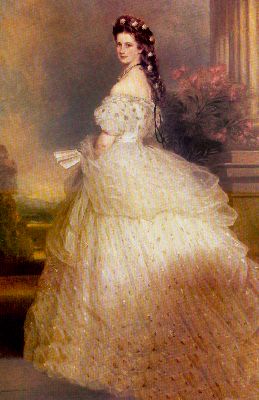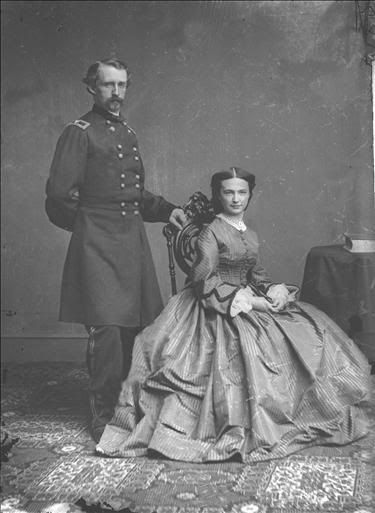Despite this involvement in history, I've found a lot of lolitas don't actually know one time period from another, or suffer from common misconceptions about them. Or, like I used to be, know an era generally but have no idea where exactly to place it in a historical time-line. If that's the case, or you simply need a little refresher, here's my basic introduction to woman's western fashion from the 1700s-1900s.
I would like to add that I went with fashion eras for dates, rather than political dates of the eras. I am by no means a historian, so I apologize for any errors.
476-1450 Medieval
1450-1600 Renaissance
1558-1603 Elizabethian
1603-1714 Baroque
1714-1795 Georgian
Also: Rococo, Colonial
This is the last era that "full dress" (the extremely elaborate, ornamental clothing worn at court) was in use. The Georgian Era, especially the Rococo movement in France, was known for it's extravagance, full skirts, and complicated layering (many dresses required being sewn into, for example). It reached it's peak in the late 1780's, with French Revolution, after which fashion became simpler and more naturalistic (as exemplified by the popular but simple chemise-style dress).
Key elements: a low neckline, a fitted at the natural waist, full ankle-length skirt, an open overskirt with exposed petticoat or underskirt, 3/4 fitted sleeves with a frill or lace ruffle at the elbow.
Movies: Interview with a Vampire (the first half), The Duchess, Marie Antoinette, Dangerous Liaisons, Amadeus, Sleepy Hollow, Casanova, The Bride.
1795-1820 Regency
Also: Directoire, Empire
This was a short, but dramatically different era- a far cry from the brocade and heavy ornamentation of Georgian fashion. Clothing in this period was generally made of light, natural fabrics in more subdued colors, for a neo-classical look. Simple, gauzy, muslin frocks without elaborate bustling or undergarments were common, even among the very rich (despite appearances, corsets were still worn during this time). Most people today are familiar with this period thanks to the works of Jane Austen.
Key elements: Low scoop neckline, empire waistline, floor length skirt, slim and narrow silhouette, bolero jackets, shawls, bonnets, gloves.
Movies: Vanity Fair, Emma, Pride and Prejudice, Becoming Jane, Wuthering Heights, Master and Commander: Far Side of the World, Count of Monte Cristo, Napoleon and Josephine.
1820-1870 Romantic/Early Victorian
Also: Antebellum, Wild West
Necklines rose quite high (with the exception of evening gowns), skirts flaired out again thanks to cage skirts and crinoline petticoats, waists tucked in, and sleeves inflated. The point of the full skirt, wide shoulders, and full sleeves was to make the waist appear as narrow as possible. Different fabric colors, patterns, and textures began to work their way into everyday dress as the industrial revolution made them more widely available.
Key elements: very full skirts, triangular bodices, covered necks and arms, capelets, pleating and pin-tucks, small fitted bonnets.
Movies: Little Women, Jane Eyre, Gone With the Wind, The Young Victoria, Cold Mountain, Great Expectations, Cranford.
1865-1895 Late Victorian
Also: Belle Epoque, Pre-Raphaelite
Finally, the voluminous skirt began to descend again and move towards the back. The bustle replaced excessive crinolines. Necklines remain high, but more shoulders and sleeves more fitted and sleek. New fabrics and dyes continued to make their way into the market, resulting in clothing that despite popular belief, was quite colorful. Military-inspired jackets and riding habits became popular. After Prince Albert's death in 1861, Queen Victoria took the fashion of mourning costume to new heights (see my post here for more).
Key elements: bustle skirts, long and fitted bodices, high collars, leg o' mutton sleeves, bonnets, military jackets, cravats/jabots.
Movies: Bram Stoker's Dracula, Interview with a Vampire (the second half), Moulin Rouge, Anne of Green Gables, The Importance of Being Earnest, Dorian Gray, Age of Innocence.
More late Victorian, because I say so: <3






















very intressting post. Thank you for posting this. I also love it that you give examples of lolita coord inspired by the period and named some films in wich the style is showed.
ReplyDeleteI think Pre-Raphaelite brotherhoos was born in the Early Victorian period. If you check some daguerrotipes from the models (the were ususally photgraphied as studio exercises) you´ll see the are all dressed on the fashion canon for that age.
ReplyDeleteIf you are interested on artistic movement, I can recommend you the BBC series Desperate Romantics.
I am sure you´ll enjoy it!
Great post! It can be difficult to keep these eras straight, so this was extremely interesting and informative. I especially love the examples you included of how historical elements from each era are translated into modern styles.
ReplyDeleteI totally have had a crush on Regency since I own Sense & Sensibility. It's interesting how things got ornate again after that period. I had things slightly out of order.
ReplyDeleteHy(:
ReplyDeleteI want to give you the Gothic Blog Award, becouse you have a wonderful blog with beautifull pictures*-*
If you accept it, write a post about it, select 3 Goth bloggers for the Award(inform them in komment later), and upload the award's picture(found it on the link).
http://dyingrose69.blogspot.com/2011/10/gothic-blog-award.html
Very interesting, I like historical paintings you've used as examples. Historical fashions are so inspiring - modern mainstream fashion is so plain by comparison, having sacrificed too much for practicality.
ReplyDeleteOne thing I would like to say is about the Pre Raphaelite fashion. Violette B mentioned the fact that the original models were earlier and generally wore the usual clothes of the early Victorian period when not modelling, but later, as the style became more popular, artsy bohemian women started wearing medieval-inspired dresses as inspired by the paintings. This was certainly not fashionable, and actually scandalous behaviour, but later went on to inspire fashionable garments as Art Nouveau gained popular acceptance and the floaty elegance of that sort of dress was seen as compatible to that aesthetic, if not taken the whole way, especially as there was a definite Arts and Crafts and historical influence to Art Nouveau anyway. William Morris is considered an Arts and Crafts figure, but he was socially linked to the PRB and went on to build his English-vernacular-meets-Gothic-revival Red House and be quite counter-cultural for his time.
This is a great run down. I'm a fan of most of these eras!
ReplyDeleteMalatya
ReplyDeleteKırıkkale
Aksaray
Bitlis
Manisa
6VEXK
Konya
ReplyDeleteKayseri
Malatya
Elazığ
Tokat
RLİ
yozgat
ReplyDeletesivas
bayburt
van
uşak
F10İ3
van
ReplyDeletekastamonu
elazığ
tokat
sakarya
AKOES
görüntülü show
ReplyDeleteücretlishow
JBY
https://titandijital.com.tr/
ReplyDeletebingöl parça eşya taşıma
kırşehir parça eşya taşıma
gümüşhane parça eşya taşıma
rize parça eşya taşıma
21TAW
588FD
ReplyDeleteBalıkesir Parça Eşya Taşıma
Kocaeli Parça Eşya Taşıma
Kırklareli Lojistik
Nevşehir Lojistik
Tokat Lojistik
AFF3D
ReplyDeleteTekirdağ Lojistik
Ardahan Şehir İçi Nakliyat
Yalova Parça Eşya Taşıma
Burdur Lojistik
Bayburt Lojistik
Aydın Parça Eşya Taşıma
Karapürçek Parke Ustası
Yobit Güvenilir mi
Bitget Güvenilir mi
ECEBF
ReplyDeleteManisa Evden Eve Nakliyat
Sincan Parke Ustası
Tunceli Evden Eve Nakliyat
Batman Evden Eve Nakliyat
Kalıcı Makyaj
Batıkent Fayans Ustası
Karaman Evden Eve Nakliyat
Ünye Oto Lastik
Keçiören Boya Ustası
F7926
ReplyDeletereferanskodunedir.com.tr
517F7
ReplyDelete%20 referans kodu
01C36
ReplyDeleteCoin Nasıl Alınır
Binance Nasıl Üye Olunur
Binance Hesap Açma
Mexc Borsası Kimin
Bitcoin Madenciliği Nasıl Yapılır
Coin Oynama
Gate io Borsası Güvenilir mi
Binance Nasıl Üye Olunur
Bitcoin Madenciliği Siteleri
45F03
ReplyDeletecanlı ücretsiz sohbet
hakkari yabancı sohbet
mardin rastgele sohbet odaları
mersin mobil sohbet bedava
elazığ mobil sohbet sitesi
osmaniye ücretsiz sohbet
samsun görüntülü sohbet uygulama
niğde görüntülü sohbet odaları
canlı sohbet siteleri
55F18
ReplyDeleteamasya bedava görüntülü sohbet sitesi
kocaeli canlı sohbet ücretsiz
ısparta görüntülü sohbet sitesi
ardahan bedava sohbet uygulamaları
bilecik rastgele sohbet uygulaması
karabük telefonda canlı sohbet
adana goruntulu sohbet
erzincan en iyi sesli sohbet uygulamaları
karaman canlı görüntülü sohbet
3A20E
ReplyDeletekaraman mobil sohbet chat
gümüşhane kadınlarla ücretsiz sohbet
manisa görüntülü sohbet yabancı
canlı sohbet ücretsiz
muş rastgele sohbet siteleri
mobil sohbet bedava
yabancı görüntülü sohbet siteleri
çankırı ücretsiz sohbet odaları
nanytoo sohbet
C3422
ReplyDeleteOnlyfans Takipçi Hilesi
Twitch Takipçi Satın Al
Soundcloud Reposts Satın Al
Bitcoin Nasıl Çıkarılır
Coin Oynama
Kwai Takipçi Satın Al
Binance'de Kaldıraç Var mı
Big Wolf Coin Hangi Borsada
Soundcloud Reposts Hilesi
6A469
ReplyDeleteLunc Coin Hangi Borsada
Kwai Takipçi Hilesi
Youtube İzlenme Hilesi
Linkedin Takipçi Satın Al
Dlive Takipçi Hilesi
Kripto Para Nasıl Çıkarılır
Threads Takipçi Satın Al
Satoshi Coin Hangi Borsada
Twitter Trend Topic Hilesi
BCFF7
ReplyDeletePinterest Takipçi Satın Al
Bitcoin Nasıl Çıkarılır
Spotify Dinlenme Hilesi
Madencilik Nedir
Soundcloud Dinlenme Hilesi
Soundcloud Dinlenme Satın Al
Aptos Coin Hangi Borsada
Kripto Para Çıkarma
Twitch İzlenme Satın Al
97014
ReplyDeletephantom wallet
shapeshift
bscpad
pudgy penguins
thorchain
sushiswap
pancakeswap
quickswap
layerzero
77143
ReplyDeletesatoshivm
layerzero
dexview
uniswap
zkswap
pudgy penguins
defillama
avalaunch
debank
0A774
ReplyDeletebitcoin giriş
kraken
kredi kartı ile kripto para alma
probit
telegram en iyi kripto grupları
cointiger
binance referans kimliği nedir
kripto telegram
en güvenilir kripto borsası
45A7B
ReplyDeletetelegram kripto para
paribu
huobi
btcturk
bkex
ilk kripto borsası
probit
kaldıraç ne demek
binance referans
C9B93
ReplyDeletekucoin
May 2024 Calendar
binance referans kimliği
referans kimliği
probit
filtre kağıdı
kucoin
February 2024 Calendar
gate io
D3283
ReplyDeletetelegram türk kripto kanalları
August 2024 Calendar
bitget
mexc
January 2024 Calendar
referans kodu binance
September 2024 Calendar
sohbet canlı
September 2024 Calendar
FGHNGNJGH
ReplyDeleteشركة تسليك مجاري
تصليح افران غاز مكه fguY5KyI4t
ReplyDeleteشركة مكافحة حشرات بالجبيل hTSg5d2Y0T
ReplyDeleteتسليك مجاري بالهفوف O9kTB2kTz9
ReplyDeleteصيانة افران الغاز بمكة Dz0MdbvexX
ReplyDeleteشركة عزل خزانات المياه EDVj50tfMg
ReplyDeleteمكافحة الحشرات بالاحساء 9rc4A55amL
ReplyDelete525CF4352A
ReplyDeletedüşmeyen takipçi satın al
3CCB0B09CF
ReplyDeletetürk bot takipçi
071DA85141
ReplyDeletetürk gerçek takipçi
9239DEB3F5
ReplyDeletetiktok ta takipçi kasma
A006596033
ReplyDeletegarantili takipçi satın al
War Robots Hediye Kodu
Online Oyunlar
Total Football Hediye Kodu
Tinder Promosyon Kodu
Bitcoin En Güvenilir Nereden Alınır
Hay Day Elmas Kodu
Bitcoin En Güvenilir Nereden Alınır
Lords Mobile Promosyon Kodu
شركة صيانة افران بجازان rVjWwJeaYR
ReplyDelete35F15B44DD
ReplyDeleteTelegram Airdrop Botları
Telegram Para Kazanma Botları
Telegram Airdrop Botları
Telegram Para Kazanma Grupları
Binance Hesabı Açma
63B80575CB
ReplyDeletegerçek organik takipçi
beğeni satın al
garantili takipçi
bot takipçi
organik takipçi
31D226C7C8
ReplyDeleteinstagram organik türk takipçi
twitter beğeni satın al
tiktok takipçi
garantili takipçi
fake takipçi